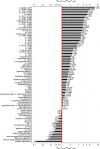A surge of p-values between 0.041 and 0.049 in recent decades (but negative results are increasing rapidly too)
- PMID: 25650272
- PMCID: PMC4312079
- DOI: 10.7717/peerj.733
A surge of p-values between 0.041 and 0.049 in recent decades (but negative results are increasing rapidly too)
Abstract
It is known that statistically significant (positive) results are more likely to be published than non-significant (negative) results. However, it has been unclear whether any increasing prevalence of positive results is stronger in the "softer" disciplines (social sciences) than in the "harder" disciplines (physical sciences), and whether the prevalence of negative results is decreasing over time. Using Scopus, we searched the abstracts of papers published between 1990 and 2013, and measured longitudinal trends of multiple expressions of positive versus negative results, including p-values between 0.041 and 0.049 versus p-values between 0.051 and 0.059, textual reporting of "significant difference" versus "no significant difference," and the reporting of p < 0.05 versus p > 0.05. We found no support for a "hierarchy of sciences" with physical sciences at the top and social sciences at the bottom. However, we found large differences in reporting practices between disciplines, with p-values between 0.041 and 0.049 over 1990-2013 being 65.7 times more prevalent in the biological sciences than in the physical sciences. The p-values near the significance threshold of 0.05 on either side have both increased but with those p-values between 0.041 and 0.049 having increased to a greater extent (2013-to-1990 ratio of the percentage of papers = 10.3) than those between 0.051 and 0.059 (ratio = 3.6). Contradictorily, p < 0.05 has increased more slowly than p > 0.05 (ratios = 1.4 and 4.8, respectively), while the use of "significant difference" has shown only a modest increase compared to "no significant difference" (ratios = 1.5 and 1.1, respectively). We also compared reporting of significance in the United States, Asia, and Europe and found that the results are too inconsistent to draw conclusions on cross-cultural differences in significance reporting. We argue that the observed longitudinal trends are caused by negative factors, such as an increase of questionable research practices, but also by positive factors, such as an increase of quantitative research and structured reporting.
Keywords: Bias; Biological sciences; Physical sciences; Science policy; Significant differences; Social sciences.
Conflict of interest statement
The authors declare there are no competing interests.
Figures























References
-
- Asendorpf JB, Conner M, De Fruyt F, De Houwer J, Denissen JJ, Fiedler K, Wicherts JM. Recommendations for increasing replicability in psychology. European Journal of Personality. 2013;27:108–119. doi: 10.1002/per.1919. - DOI
-
- Basu S, Park HU. 2014. Publication bias in recent empirical accounting research. Available at http://ssrn.com/abstract=2379889 .
LinkOut - more resources
Full Text Sources
Other Literature Sources

